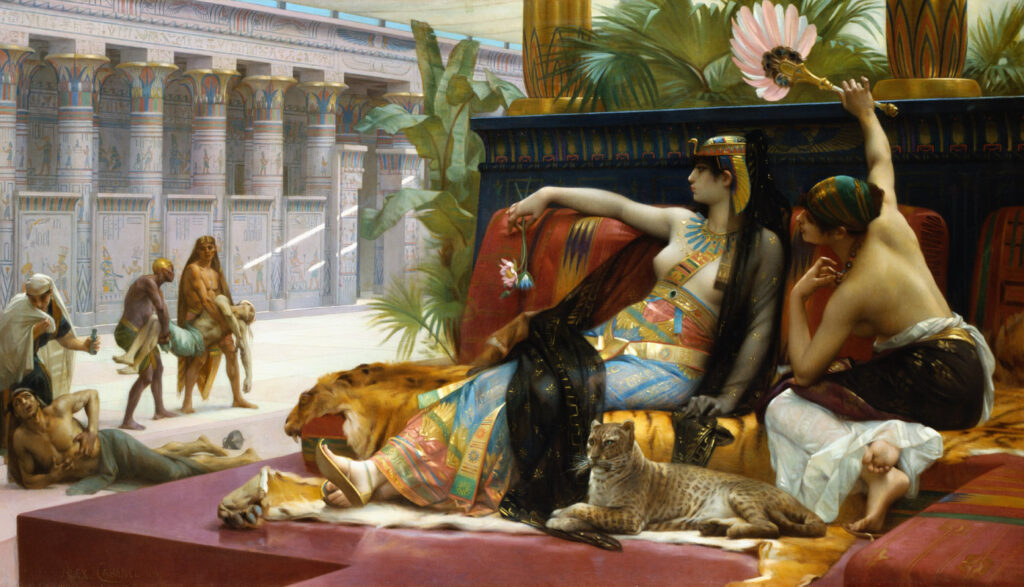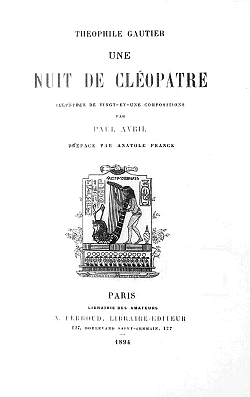(Une nuit de Cléopâtre)
Théophile Gautier
1838
(A young hunter is willing to die to be with queen Cleopatra for just one evening.)

Word for word, this little novella (three times the length of a typical short story at about 12,700 words) probably paints the most vibrant description of ancient Egypt in all of literature. This is my favorite aspect of the work, though for others it might be the engaging romantic plot, or the typical though attractive take on the queen’s psychology. It is a simple tale, but richly set and beautifully told.
 As the story opens, a sumptuous cangia– her famous barge– slips down the Nile. The last Pharaoh herself within the boat moans to her favorite slave Charmion that she needs love, and without it Egypt’s beauties are monstrous to her. Is love what she really wants, though? Later we are told she “prayed for a new pleasure, for some fresh sensation”, suggesting that she is rather a desensitized decadent, and that love itself would not hold her interest for long.
As the story opens, a sumptuous cangia– her famous barge– slips down the Nile. The last Pharaoh herself within the boat moans to her favorite slave Charmion that she needs love, and without it Egypt’s beauties are monstrous to her. Is love what she really wants, though? Later we are told she “prayed for a new pleasure, for some fresh sensation”, suggesting that she is rather a desensitized decadent, and that love itself would not hold her interest for long.
Meanwhile a young Tom Sawyerish hunter Meïamoun (or Ammon in some translations) follows her about with his canoe, in love with her to the point of recklessness. Later, lurking about her palace, he sends an arrow into her chambers with an attached note. Of course this succeeds in piquing her interest. The youth returns to watch her bathe, but is caught. He confesses his love, and she decides out of sympathy and playfulness to postpone capital punishment until she has given him an evening with her. Meïamoun is more than willing to accept this arrangement, and is in paradise as they dine in opulence and mutual affection.
Download this SPOILER if you want the ending revealed.
I think it a pity that French Romanticism died so young…. the movement started earlier and held on longer in England where, ironically, folks tend to be less romantic. (This is consistent with a hypothesis in cultural evolutionary theory that a fashion boom is associated with bust, whereas a slower rise predicts greater longevity). But while it lasted, in the first few decades of the 19th century, the French imagination soared, without those dark reins– call them realist, naturalist, dissident, existentialist, whatever– that have shaped that nation’s literature ever since. Gautier’s picture of the beauty and luxury of the Nile civilization is unimpeachable– we shall neither gild nor even examine the lily. But (and here we’ll lay the marvelous story to rest, and instead self-consciously get pedantic) what of the author’s take on the passionate Cleopatra?
I have already brought up the ambiguity in Cleopatra’s idea of love as Gautier represents it. This ambiguity is evident again when we discover that she is currently with Antony. Her relationship with the Roman general is one of the iconic love stories in all the world, and yet we see Cleopatra pining for a new love?! Hmmm. So Gautier’s Cleopatra is perhaps not really in love with Antony… yet she does shed a tear for Meïamoun… but readily shakes it off… but perhaps by necessity. The strategy here is to portray a genuine soft spot in an ostensibly self-absorbed monarch. It is a touching and effective device. It partly relies, however, on a view of Cleopatra that deserves closer examination.
Gautier is well within ancient professional opinion (e.g., Plutarch, Appian, Athenaeus, Josephus, Suetonius, Cassius Dio…) that Cleopatra was very intelligent (unfortunately Elizabeth Taylor’s film interpretation missed this), and sensual (um, Liz did not miss this). Was she astonishingly attractive physically as well? Gautier is effusive about this, but the ancient writers are not so clear: Plutarch was under the impression that it was mainly her powers of conversation and her charisma that attracted her men. But then again we must consider Josephus’ statement that Antony was crazily in love with her nigh unto slavery. And before that, she had the gumption to have herself rolled up in a carpet nude and presented surreptitiously to Caesar… and it worked! Seems like there is a bit more than smarts and personality going on here. But what is even more suspicious about the ancient writers is the way that certain of them– especially those who were fans of her adversary Octavian– call her a wanton whore. Hints of her promiscuity and sexual insatiability are sprinkled among the Roman accounts, but nobody is specific. No particular allegations are made, just little jabs. In fact the only relationships we know of are Caesar and Antony, not counting the legally mandated and almost certainly platonic consortships with her brothers.
Nevertheless, the view we have of Cleopatra today is shaped by rumors deriving ultimately from those sneers of a few Roman historians writing a century after her death. Why did they dislike her so? Part of it is probably that the Rome of that time considered Egypt depraved to start with. Consider, though, why in general we might see a man simultaneously calling an attractive woman a slut even as he tries to find fault with her beauty. Some sort of resentment, perhaps? In this case, for one thing Cleopatra claimed divinity, both in terms of her own Isis and also the Roman Venus. Pretty cheeky. But one bald fact provides the most potent explanation for Rome’s resentment: in the words of Cassius Dio, “She captivated two of the greatest Romans of her day.” Plain and simple. She was a foreign seductress, messing with the best thing that ever happened in the world. She was an Egyptian Yoko Ono, who broke up the Roman Beatles and drove the main man looney with her stimulating conversation and kisses. So all the fans hated her, and they continued to do so with the passing generations when writing their histories. Then, eighteen hundred years later, Gautier has her toying with a man’s heart and life while Antony is away– though, to be fair, not without a touch of tender humanity.
Critique of the perennial Cleopatra rumor-mill is standard fare in contemporary historical writing, not surprisingly as we are particularly sensitive today to a bunch of men attacking a woman in a position of power. But if we look around at the finger-waving nowadays, there is something disturbing about much of it. For some reason, we are being asked to make a false dichotomy between sexuality and acumen: was she a playful sex kitten, or a sharp and ambitious career woman? That is largely the question posed to us today, and of course we are supposed to answer the latter, even as the arts portray the former. Are we supposed to forget about her trademark translucent silk? Her milk baths? Or, if the historicity of these is suspect, we simply cannot undo her body rolling out of a carpet, a book on cosmetics attributed to her, and her ability to reel in two of the most powerful men in the world. The fact of the matter is that she can have been, and appears very much to have been, unabashedly sensual and politically astute at the same time. If this injures a variety of feminist sensibility (“how dare you demean her as a sex object!”) or a variety of male chauvinism (“smart + sexy = oil + water”), that’s really just too bad. Here we have the lover, perhaps “Clea”, vixen to die for as Antony would discover, who is at the same time the proud and mighty Pharaoh Cleopatra VII Philopator (Κλεοπάτρα Φιλοπάτωρ), who stood upholding Egypt in the face of of a foreign superpower for as long as any leader could have, until the Roman juggernaut rolled over her ancient civilization. And so she died– took her life “as lovers often do”. She died the lover both of Antony and of Egypt, even as both of them died in her lap– her two facets tragically in unison.
Tidbits of Significance
(translated from the French anonymously, Black’s Readers Service, 1928)
Upon this strange pillow reposed a most charming head,—one look of which once caused the loss of a half-a-world,—an adorable, a divine head; the head of the most perfect woman that ever lived,—the most womanly and most queenly of all women; an admirable type of beauty which the imagination of poets could never invest with any new grace, and which dreamers will find forever in the depths of their dreams: it is not necessary to name Cleopatra.
-ch.1.
“…the vertigo of enormity,—the drunkenness of the gigantic,—the reckless efforts of that pride which would at any cost engrave its name deeply upon the face of the world!”
-Cleopatra, of Egypt, ch.2.
“Disembowel the sky with gigantic triangles of stone,—you cannot hereby lengthen your corpse an inch.”
-Cleopatra, of Egypt, ch.2.
O cruel lot, that so many insensible objects should enjoy the favors which would ravish a lover with delight! The wind which toys with a wealth of perfumed hair, or kisses beautiful lips with kisses which it is unable to appreciate; the water which envelopes an adorably beautiful body in one universal kiss, and is yet notwithstanding indifferent to that exquisite pleasure; the mirror which reflects so many charming images; the buskin or tatbeb which clasps a divine little foot:—oh, what happiness lost!
-as Cleopatra disrobes and enters her bath, ch.5.
Tips
READ THIS WHEN…
…you could use a brief whisking-away to the sensual Nile;
or
…you are obsessed with a distant and queenly woman and wish for some encouragement.
IF YOU LIKE THIS, YOU’D LIKE:
(For those smitten by Cleopatra:)
- Plutarch, “Antony”, in Parallel Lives (early 2nd century).
- William Shakespeare, Antony and Cleopatra (1606-1607)
- John Dryden, All for Love (1677)
- Sarah Fielding, Lives of Cleopatra and Octavia (1757)
- George Bernard Shaw, Caesar and Cleopatra (1901)
(For the heart that beats for the French romantics:)
- Alphonse de Lamartine, Poetical Meditations (1820)
- Alfred de Vigny, Chatterton (1835)
- Charles Baudelaire, The Flowers of Evil (1857)
- Victor Hugo, Les Miserables (1862)
Find It!
Tragically, despite Gautier’s beautiful work, only Mademoiselle de Maupin is in print in English in either hardcover or paperback from a major publisher. Ballentine had planned to release it a while back but it never materialized. So you have two options: go used, or try out a publisher that is less well-known and could be just fine or else an ugly facsimile. It’s a gamble. Here are a couple of examples. Very affordable but neither have any reviews so caveat emptor.
Hardcover: Zephyr books.
Paperback: CreateSpace.
If you go used, the English translation of the novella was originally published as one of several stories in One of Cleopatra’s Nights and Other Fantastic Romances, translated by Lafcadio Hearn. Most of the reprints available today are of that edition. My own copy is from the one-volume Black’s Readers Service Works of Gautier, which is a good collection. The old Modern Library version of Mademoiselle actually includes One of Cleopatra’s Nights and so would likewise be a good find.









